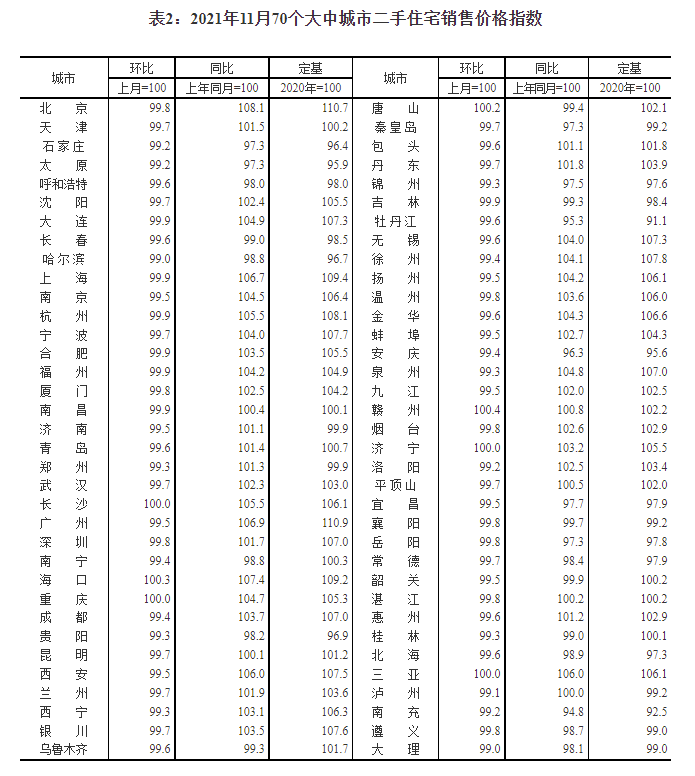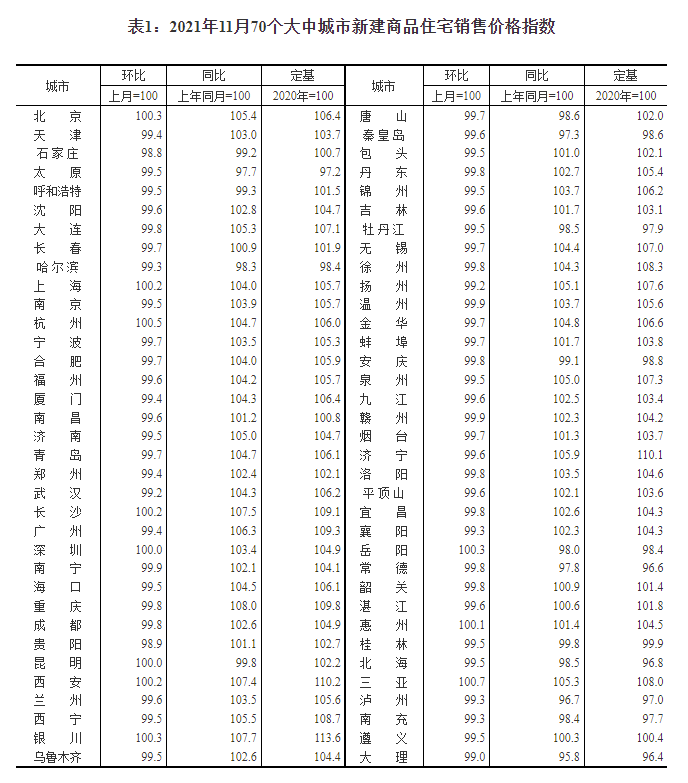In November, the overall decline in housing prices in 70 large and medium-sized cities continued. This month, the number of new homes and second-hand housing cities continued to decrease, and both have fallen to single digits, reaching the lowest level in the past two years.
On December 15, the National Bureau of Statistics released the changes in the sales prices of commercial housing in 70 large and medium-sized cities in November 2021. According to the housing price data of 70 large and medium-sized cities across the country, the number of newly-built commercial housing prices rose in 9 cities in November, a decrease of 4 from the previous month; 2 cities were flat, a decrease of 3 from the previous month; 59 cities fell, compared with the previous month Increase 7 cities. Looking at the second-hand residential housing price index in November, the number of rising cities was 3, one less than the previous month; 4 cities were flat, 2 more than the previous month; 63 cities fell, 1 less than the previous month.
Sheng Guoqing, chief statistician of the City Department of the National Bureau of Statistics, explained that in November 2021, the sales prices of commercial housing in 70 large and medium-sized cities continued to decline from the previous month, and the year-on-year increase continued Fall back.
The number of cities with rising housing prices has dropped to single digits
According to data from the National Bureau of Statistics, in November, the sales price of second-hand housing in first-tier cities fell by 0.2 month-on-month %, the decline narrowed by 0.2 percentage points from the previous month. Among them, Beijing, Shanghai, Guangzhou and Shenzhen fell by 0.2%, 0.1%, 0.5% and 0.2% respectively. The sales price of second-hand housing in second-tier cities fell by 0.4% month-on-month, and the rate of decline expanded by 0.1 percentage point from the previous month. The sales price of second-hand housing in third-tier cities fell by 0.4% month-on-month, and the rate of decline was 0.1% larger than the previous month. Among the first-tier cities, second-hand house prices in Beijing, Shanghai, and Guangzhou have all dropped in three consecutive times.
Overall, in November, among the 70 large and medium-sized cities, there were 63 cities where second-hand housing prices fell, while only 3 cities showed rising housing prices. 
Source: National Bureau of Statistics
These three cities are Haikou, Tangshan, and Ganzhou. Second-hand houses in Haikou rose 0.3% month-on-month; second-hand houses in Tangshan rose 0.2% month-on-month; and Ganzhou second-hand houses rose 0.4% month-on-month.
In addition to the increase in housing prices, the number of cities has decreased.The biggest decline in the declining cities has also increased.
According to the National Bureau of Statistics, among the 70 large and medium-sized cities in November, the biggest decline in house prices was 1%, an increase of 0.1% from the previous decline. In terms of trends, house prices in first- and second-tier cities have slowly fallen, but the decline in third- and fourth-tier cities has gradually expanded. For example, Dali and Harbin fell by 1%.
” Some cities in North China and Northeast China, such as Shijiazhuang, Taiyuan, Harbin, Changchun, and other cities, have seen their housing prices drop particularly. The important reason lies in this, but from the perspective of recent city policies, most of them are point-shaped tentative policies, which will slow down the downward trend to a certain extent, and it is difficult to reverse the downward trend of the market. It is expected that policies in some cities will be introduced in the later period to further improve Enhance market confidence and stabilize the market.” said Zhang Bo, Dean of 58 Anju Guest House Industry Research Institute.
Xu Xiaole, chief market analyst of the Shell Research Institute, pointed out that the weaker second-tier and third- and fourth-tier cities are dominated by weaker second-tier and third- and fourth-tier cities whose declines continue to expand. The overall support for housing demand in these cities is relatively weak, and it will take longer for market expectations to build a bottom and improve.
Xu Xiaole mentioned that, overall, the decline in housing prices is expected to gradually narrow in the later period. According to data from the Shell Research Institute, the second-hand housing transaction volume of Shell 50 City continued to rebound from October to November, showing signs of bottoming in the market. According to the basic law of “quantity comes before price”, the initial bottoming of the quantity will lay the foundation for the later price to stop falling. In terms of expectations, since December, the second-hand housing boom index of Shell 50 cities has stopped falling and improved. Among them, key cities in the Yangtze River Delta and Pearl River Delta regions are expected to improve relatively more significantly.
Real estate companies sprinted for the year’s performance, and the number of cities where new house prices fell.
According to data from the National Bureau of Statistics, the number of cities where newly-built commercial housing prices rose in November 9 cities, a decrease of 4 cities from the previous month; 2 cities that remained unchanged, a decrease of 3 from the previous month; 59 cities that fell, an increase of 7 cities from the previous month. 
Source: National Bureau of Statistics
Chen Xiao, a senior analyst at the Zhuge Housing Search Data Research Center, pointed out that entering November 2021, as the epidemic returns, the lineUnder the pressure of the three red lines, real estate companies urgently need to withdraw funds. In order to accelerate sales recovery, real estate companies have strengthened their marketing efforts and sold at lower prices under the pressure of three red lines. Increased behavior.
From the perspective of growth and decline, the average decline in 70 cities was 0.33%, an increase of 0.08 percentage points from the previous month; the average growth rate of rising cities was 0.31%, and the month-on-month increase was closed. Narrow by 0.03 percentage points. In terms of tiered cities, the sales prices of newly-built commercial residential buildings in first-tier cities remained the same month-on-month. Among them, Beijing rose by 0.3% month-on-month, down 0.3 percentage points from the previous month, Shanghai rose 0.2% month-on-month, an increase of 0.1 percentage points from the previous month, and Guangzhou fell 0.6%, and the rate of decline continued to expand. The sales prices of new commercial residential buildings in second-tier and third-tier cities fell by 0.4% and 0.3% respectively from the previous month.
Chen Xiao believes that overall, in the overall downturn of the industry, the “resistance” of first-tier cities is still higher than that of second- and third-tier cities.
According to the data released by the National Bureau of Statistics, in November this year, the cities where new house prices showed an increase were Beijing, Shanghai, Hangzhou, Changsha, Xi’an, Yinchuan, and Yueyang. , Huizhou, Sanya. Among them, Sanya’s new houses saw the highest month-on-month increase, with a month-on-month increase of 0.7%; Hangzhou followed, with a month-on-month increase of 0.5%. Beijing, Yinchuan, and Yueyang followed closely, with a month-on-month increase of 0.3%, while Shanghai, Changsha, and Xi’an rose by 0.2% from the previous month.
Zhang Bo said that from the data on housing prices in 70 large and medium-sized cities released by the Statistics Bureau, the market’s cooling trend continued in November, and new houses were only flat in first-tier cities. The rest have declined to varying degrees, while the decline in second-hand housing is more comprehensive. This is also a month in which the property market price cuts have been more pronounced this year. It also indicates that the market is gradually approaching the bottom, and the space for policy contraction has narrowed. Relaxation policies in some cities and regions will continue to emerge to promote the steady development of real estate. However, the downward trend is not expected to change sharply in December. The market before the Spring Festival will still maintain a cooling trend, but the rate of cooling is expected to gradually narrow.
Looking forward to the future, Xu Xiaole believes that at the policy level, the Politburo meeting and the Central Economic Work Conference pointed out that “support the commercial housing market to better meet the reasonable housing needs of buyers”, “City-based policies promote a virtuous circle and healthy development of the real estate industry”. It is expected that the housing credit environment will be further improved in the later period. Due to city-based policies, some cities may introduce supportive policies for first homes and improved housing, which will accelerate the bottoming of market transactions. The rebound will ease the downward pressure on housing prices.